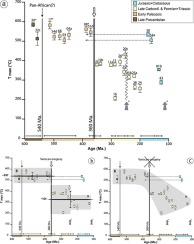当前位置:
X-MOL 学术
›
J. Asian Earth Sci.
›
论文详情
Our official English website, www.x-mol.net, welcomes your feedback! (Note: you will need to create a separate account there.)
Fossil thermal structure of the southern Sanandaj-Sirjan zone (SW Iran): Implications for regional-scale tectonics
Journal of Asian Earth Sciences ( IF 3 ) Pub Date : 2020-09-01 , DOI: 10.1016/j.jseaes.2020.104488 Parisa Gharibnejad , Philippe Agard , Claudio L. Rosenberg , Jafar Omrani , Ali Kananian
Journal of Asian Earth Sciences ( IF 3 ) Pub Date : 2020-09-01 , DOI: 10.1016/j.jseaes.2020.104488 Parisa Gharibnejad , Philippe Agard , Claudio L. Rosenberg , Jafar Omrani , Ali Kananian

|
Abstract The Sanandaj-Sirjan Zone (SSZ) is one of the Cimmerian blocks accreted to Eurasia during the Late Triassic and the only tectonic unit of the Zagros orogen affected by Barrovian metamorphism. Both the age and absolute temperature of this metamorphic event are still poorly defined. In the present study, we use the Raman Spectrometry of Carbonaceous Material (RSCM) to estimate maximum temperatures attained in the southern SSZ, along two SW-NE cross-sections. While maximum obtained temperature for Precambrian to Jurassic rocks ranges from ~200 to ~600 °C, all Precambrian and Early Paleozoic samples record temperatures >500 °C. Results thus reveal the existence of a major temperature contrast between Precambrian to Devonian samples (showing Tmax > 500 °C) and Late Devonian to Cretaceous ones (Tmax
中文翻译:

Sanandaj-Sirjan 地区南部(伊朗西南)的化石热结构:对区域尺度构造的影响
摘要 Sanandaj-Sirjan带(SSZ)是晚三叠世期间增生到欧亚大陆的Cimmerian地块之一,是扎格罗斯造山带唯一受巴罗夫变质作用影响的构造单元。这个变质事件的年龄和绝对温度仍然不明确。在本研究中,我们使用碳质材料的拉曼光谱 (RSCM) 来估计南 SSZ 沿两个 SW-NE 横截面达到的最高温度。虽然前寒武纪至侏罗纪岩石获得的最高温度范围为 ~200 至 ~600 °C,但所有前寒武纪和早古生代样品记录的温度均 >500 °C。因此,结果揭示了前寒武纪到泥盆纪样本(显示 Tmax > 500 °C)和晚泥盆纪到白垩纪样本(Tmax
更新日期:2020-09-01
中文翻译:

Sanandaj-Sirjan 地区南部(伊朗西南)的化石热结构:对区域尺度构造的影响
摘要 Sanandaj-Sirjan带(SSZ)是晚三叠世期间增生到欧亚大陆的Cimmerian地块之一,是扎格罗斯造山带唯一受巴罗夫变质作用影响的构造单元。这个变质事件的年龄和绝对温度仍然不明确。在本研究中,我们使用碳质材料的拉曼光谱 (RSCM) 来估计南 SSZ 沿两个 SW-NE 横截面达到的最高温度。虽然前寒武纪至侏罗纪岩石获得的最高温度范围为 ~200 至 ~600 °C,但所有前寒武纪和早古生代样品记录的温度均 >500 °C。因此,结果揭示了前寒武纪到泥盆纪样本(显示 Tmax > 500 °C)和晚泥盆纪到白垩纪样本(Tmax


























 京公网安备 11010802027423号
京公网安备 11010802027423号